About Hawaii
There are six major islands to visit in Hawaii: Kauai, Oahu, Molokai, Lanai, Maui, and the Island of Hawaii! Each has its own distinct personality, adventures, activities and sights. We invite you to explore the Islands of Aloha to find your own heavenly Hawaii experiences.
If Oahu is the heart of Hawaii, then Honolulu is its racing pulse. In this cosmopolitan capital city, you will find everything from historic landmarks to fine dining to world-class shopping. Home to the majority of Oahu’s population, Honolulu stretches across the southeastern shores of the island, from Pearl Harbor to Makapuu Point, encompassing world-famous Waikiki Beach along the way.
Arts & Culture in Honolulu
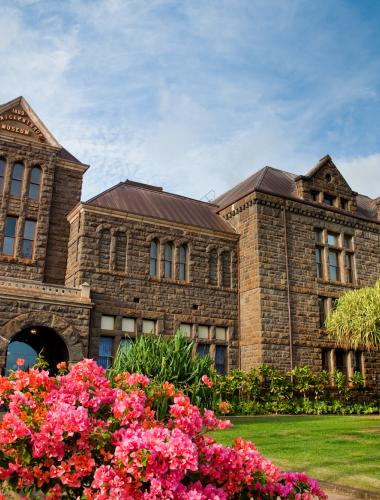
The Bishop Museum
Honolulu’s Bishop Museum is Hawaii’s largest museum dedicated to studying and preserving the history of Hawaii and the Pacific. Originally designed to house the extensive collection of Hawaiian artifacts and royal family heirlooms of Princess Bernice Pauahi Bishop, a descendant of King Kamehameha I, the museum is now the premier natural and cultural history institution in the Pacific. One of Oahu’s most historic places, the museum holds millions of artifacts, documents and photos about Hawaii and other Polynesian cultures.
Visit the newly renovated Hawaiian Hall, which immerses you in Native Hawaiian culture and history by showcasing a variety of important artifacts. In the planetarium, kids can learn how voyagers navigated the Pacific using the stars. In the Science Adventure Center, children can see Hawaii’s unique natural environment like never before through a variety of interactive exhibits.
The museum is open seven days a week (excluding some holidays) with regular hours from 9 a.m. to 5 p.m.
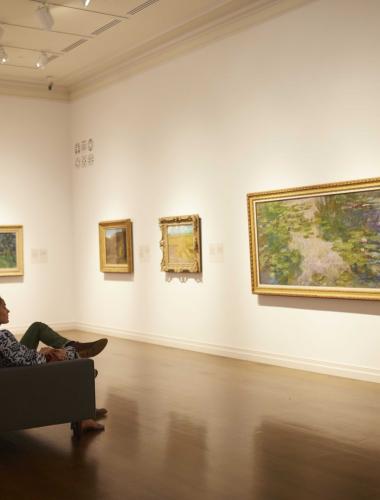
The Honolulu Museum of Art
Not far from Downtown Honolulu, the Honolulu Museum of Art has been sharing the arts with Hawaii since 1927. With a permanent collection of more than 60,000 pieces, this is Hawaii’s largest general fine-arts museum.
Stroll from gallery to gallery past open-air courtyards and ponds. Explore one of the finest collections of Asian art in the world as well as impressive collections of Western, European and Polynesian art. If you feel like seeing a film, visit Doris Duke Theatre, which plays an impressive slate of foreign and independent films. After browsing the galleries, take a break to have lunch in the open-air HoMA Cafē or recharge with an energizing drink at the Coffee Bar.
Shangri La Museum of Islamic Art, Culture & Design
Shangri-La is a center for Islamic arts and cultures, offering guided tours of what was formerly the home of American heiress and philanthropist Doris Duke. Built in 1937, Shangri La was inspired by Duke’s extensive travels throughout North Africa, the Middle East, and South Asia.
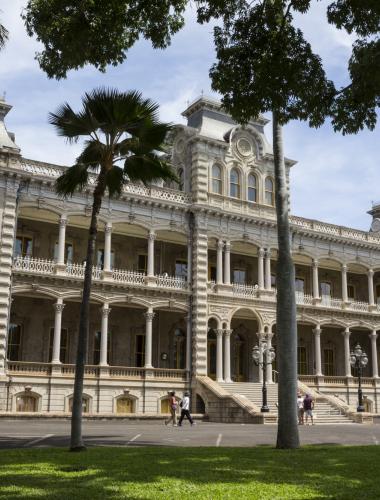
Iolani Palace
A national historic landmark and the only official state residence of royalty in the United States, from 1882 to 1893 Downtown Honolulu’s Iolani Palace was the official residence of the Hawaiian Kingdom’s last two monarchs: King Kalakaua and his sister and successor, Queen Liliuokalani.
The palace was a symbol of promise for the Hawaiian Kingdom built by King David Kalakaua, “The Merrie Monarch.” Influenced by European architectural styles, this royal residence included Hawaii’s first electric light system, flush toilets and intra-house telephones. The rich interior features a beautiful koa staircase, dramatic portraits of Hawaiian royalty, ornate furniture and royal gifts and ornaments from around the world.
In 1893, a provisional U.S. government was established after opposition forces overthrew the Hawaiian monarchy. The Hawaiian Islands were eventually annexed as a United States Territory in 1898. Hawaii became the 50th state in 1959 and during this time Iolani Palace was used as the capitol building until 1968. After falling into disrepair over the years, the Iolani Palace was renovated and opened to the public in 1978.
More Places to See in Honolulu
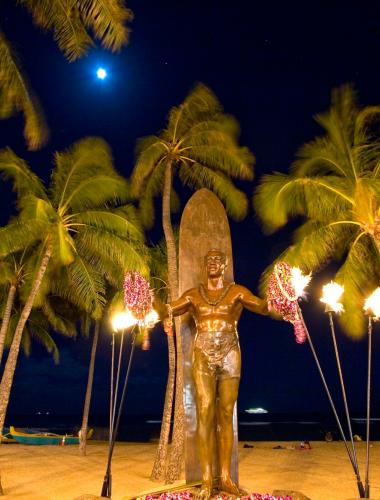
Duke Kahanamoku Statue
On Kuhio Beach, a bronze statue of Duke Kahanamoku welcomes you to Waikiki with open arms. Duke was a true Hawaiian hero and one of the world’s greatest watermen, a master of swimming, surfing and outrigger canoe paddling.
Duke Paoa Kahanamoku was born on August 24, 1890. He grew up swimming and surfing in Waikiki near the current Hilton Hawaiian Village Waikiki Beach Resort. Discovered as a swimming sensation, Duke’s legend began when he broke the world record in the 100-yard freestyle during his very first competition. The prodigious Duke went on to win Olympic gold in the 100-meter freestyle and silver in the relay in 1912. He also won two gold medals in 1920 and won a silver medal at age 34 in the 1924 Olympics.
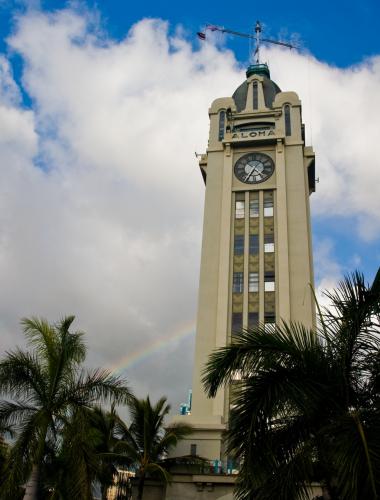
Aloha Tower
Located on the Honolulu Harbor in Downtown Honolulu, about 15 minutes west of Waikiki, Aloha Tower is an iconic symbol of Hawaii. Built in September of 1926, this was the tallest building in the islands for four decades and its clock was one of the largest in the United States. The tower stood as a welcoming beacon for visitors since travel to Oahu was done entirely by sea. Duke Kahanamoku set his first swimming world record here at Pier 7 and the wharf was also known for Boat Days, a lively celebration to welcome the arrival of visiting ships.
You can also visit the Observation Deck, located on the 10th floor of Aloha Tower and dine at Gordon Biersch or Hooters, or dance at the night away at Nashville Waikiki—all with beautiful views of the harbor on one side and the cityscape of Honolulu on the other.
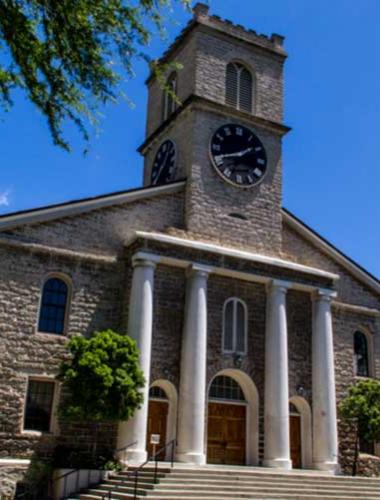
Kawaiahao Church
Known as the “Westminster Abbey of the Pacific,” Kawaiahao Church was the first Christian Church built on Oahu. Dedicated on July 21, 1842, “The Great Stone Church” is made of 14,000 coral slabs from ocean reefs that were hauled from the sea by native laborers and missionaries. The church and the grounds were named a National Historic Landmark in 1962.
As you stroll the streets of Downtown Honolulu, you may hear the sound of bells from the tower clock. “Kauikeaouli clock,” donated by King Kamehameha III in 1850, still tolls the hours to this day. To the right of the entrance you’ll find the peaceful tomb of King Lunalilo. This popular King ruled for just a little over one year and he wished to be buried “among his people” at Kawaiahao Church rather than in the Royal Mausoleum. To the left of the church you’ll also find the Kawaiahao Fountain. The High Chiefess Hao bathed in this sacred spring, giving the church its name: Ka Wai a Hao, or the water of Hao.
Oahu Dining
Oahu is home to the metropolitan center of Hawaii, and its vibrant dining scene means that it’s an excellent place to find creative and delicious food representing diverse cultures. Splurge on dinner at one of the buzzworthy high-end spots in Honolulu, or save your vacation funds by finding tasty fare at casual spots, coffee shops and food trucks. On Oahu, you can eat like a local in smaller neighborhoods like Kapahulu or dine in high style at Hawaii’s top-rated restaurants in neighborhoods like Waikiki, Kaimuki and Chinatown.
Oahu is home to some of the best chefs in the world. Alan Wong (Alan Wong’s Restaurant), Roy Yamaguchi (Roy’s Waikiki), George Mavrothalassitis (Chef Mavro Restaurant) and Phillippe Padovani (Elua) were some of the founding chefs of the Hawaii Regional Cuisine movement 25 years ago, and their legacy has continued to spark Oahu’s restaurant renaissance today. These local legends take the freshest local produce and ingredients to create flavorful dishes, combining traditional Hawaiian cooking with influences from Japan, China, the Philippines and classic American cuisine among many others.
Find more OAHU dining here.